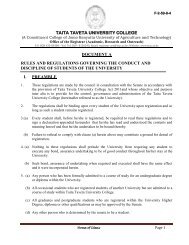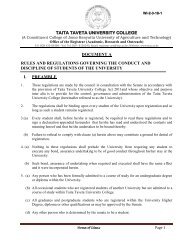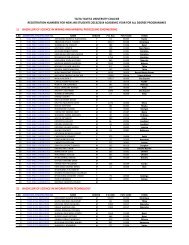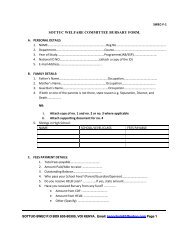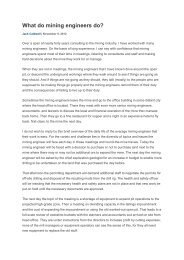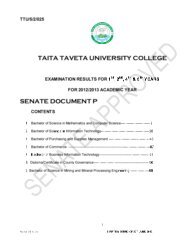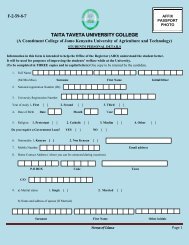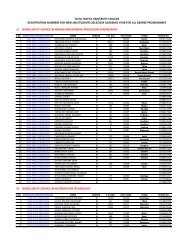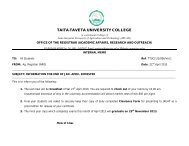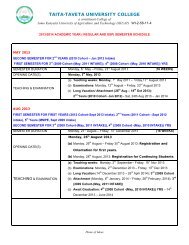Conference Book of Abstracts - Taita Taveta University College
Conference Book of Abstracts - Taita Taveta University College
Conference Book of Abstracts - Taita Taveta University College
- No tags were found...
Create successful ePaper yourself
Turn your PDF publications into a flip-book with our unique Google optimized e-Paper software.
while from Kisii had the lowest cyanide concentration (43.27 mg/kg). Nairobi and Thika hadmoderately high concentration <strong>of</strong> 66.00 and 54.84 mg HCN equivalents/kg cassava fresh weight.During the period <strong>of</strong> study, two families, a family <strong>of</strong> six(6) and <strong>of</strong> seven(7) from Makueni andKathonzweni districts in Eastern Province were effected after consuming raw and cookedcassava in the month <strong>of</strong> September 2011, where two (2) children aged four(4) and five(5) diedand other family members were taken ill to Makueni District Hospital. The cyanide levels in thecassava were high, and ranged between 46.03 and 53.37 mg HCN equivalents/kg fresh cassavaweight. Cassava from all the regions registered high levels <strong>of</strong> cyanide compared to therecommended accepted level <strong>of</strong> 10 mg/kg per body weight by WHO. There is need for publicawareness on processing <strong>of</strong> cassava before consumption.Impact <strong>of</strong> Prolonged Application <strong>of</strong> Xenobiotics on Indigenous Microbes in SoilAnastasia Ngigi 1 , David Ndalut 2 , Hamadi Boga 3 , Zachary Getenga 21 Masinde Muliro <strong>University</strong> <strong>of</strong> Science & technology, P.O. Box Box 190 – 50100, Kakamega.2 Chepkoilel <strong>University</strong> <strong>College</strong>, 3 Jomo Kenyatta <strong>University</strong> <strong>of</strong> Agriculture and TechnologyEmail: anjokingugi@yahoo.comThe environmental fate <strong>of</strong> herbicides is a matter <strong>of</strong> major concern given that only a small fraction<strong>of</strong> the chemicals reach the target organisms. This leads to potential negative impacts <strong>of</strong> residualherbicides on human, animal and crop health. Herbicides affect microbes indirectly, causingphysiological changes, increased enzymatic production or, when applied in high doses, death <strong>of</strong>susceptible groups <strong>of</strong> microorganisms. In most cases they lead to the indigenous microbesgetting adapted to the xenobiotics by utilizing the same for energy and growth. In soil systems,biodegradation is a fundamental attenuation process for pesticides. This study reports themicrobial adaptation to atrazine and diuron herbicides in soils. Atrazine (6-chloro-N 2 -ethyl-N 4 -isopropyl-1,3,5-triazine-2,4-diamine) and diuon [N-(3,4-dichlorophenyl)-N,N-dimethylurea]herbicides are extensively and frequently applied in sugarcane-cultivated soils. Soils have beenscreened for the rapid degradation <strong>of</strong> the xenobiotics by evolution <strong>of</strong> 14 CO 2 from the utilization<strong>of</strong> the 14 C-labelled compounds, by measuring bacterial cell density through optical densitymeasurements and by measuring the residual levels <strong>of</strong> the xenobiotic at different time intervals.For instance, two model compounds (diuron and atrazine) have been extensively studied withsubsequent isolation and characterization <strong>of</strong> the key microorganisms which have been adapted tothe utilization <strong>of</strong> the xenobiotics for energy and growth. In this study, liquid culture experimentswith atrazine and diuron led to isolation <strong>of</strong> different bacterial strains that could degrade the twoherbicides. This confirms the adaptation <strong>of</strong> indigenous microbes to herbicides after repeatedapplications.Key words: atrazine, diuron, biodegradation, adaptation, liquid culturesThe Role <strong>of</strong> Horticultural Association <strong>of</strong> Kenya (HAK) in Conservation and Utilization <strong>of</strong>Biodiversity in KenyaJohn Mwibanda Wesonga



